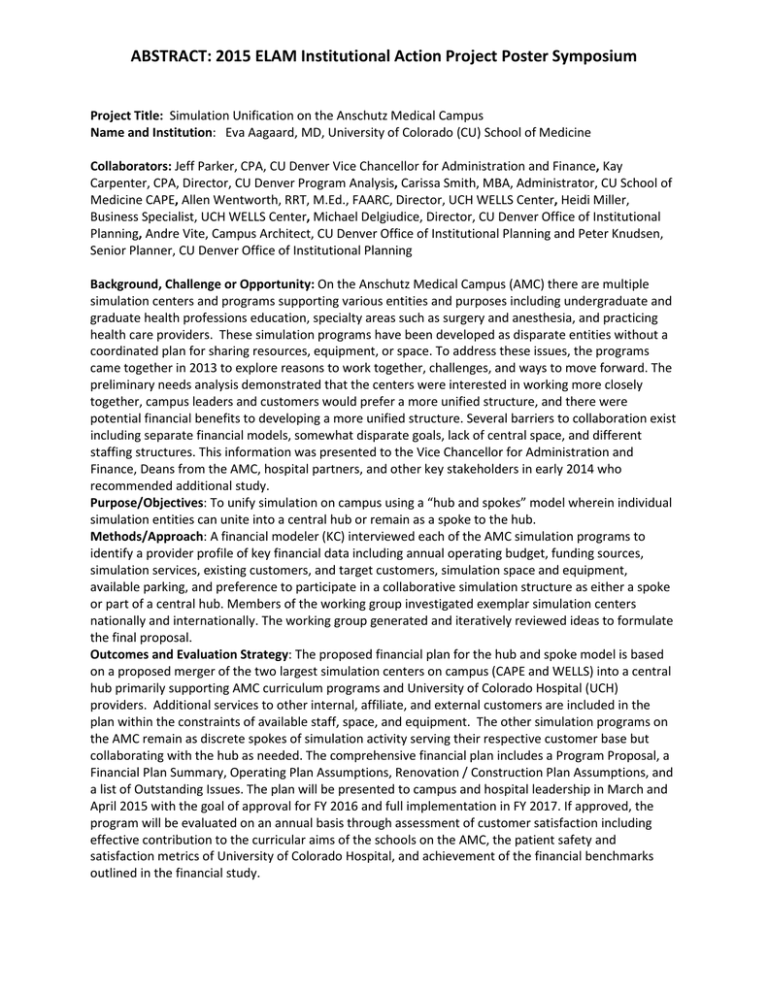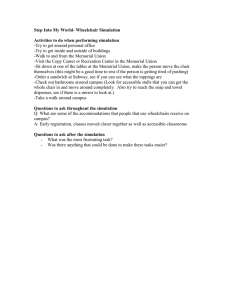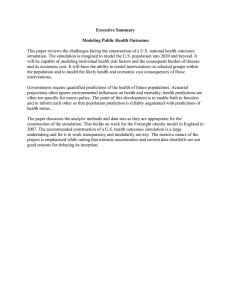ABSTRACT: 2015 ELAM Institutional Action Project Poster Symposium
advertisement

ABSTRACT: 2015 ELAM Institutional Action Project Poster Symposium Project Title: Simulation Unification on the Anschutz Medical Campus Name and Institution: Eva Aagaard, MD, University of Colorado (CU) School of Medicine Collaborators: Jeff Parker, CPA, CU Denver Vice Chancellor for Administration and Finance, Kay Carpenter, CPA, Director, CU Denver Program Analysis, Carissa Smith, MBA, Administrator, CU School of Medicine CAPE, Allen Wentworth, RRT, M.Ed., FAARC, Director, UCH WELLS Center, Heidi Miller, Business Specialist, UCH WELLS Center, Michael Delgiudice, Director, CU Denver Office of Institutional Planning, Andre Vite, Campus Architect, CU Denver Office of Institutional Planning and Peter Knudsen, Senior Planner, CU Denver Office of Institutional Planning Background, Challenge or Opportunity: On the Anschutz Medical Campus (AMC) there are multiple simulation centers and programs supporting various entities and purposes including undergraduate and graduate health professions education, specialty areas such as surgery and anesthesia, and practicing health care providers. These simulation programs have been developed as disparate entities without a coordinated plan for sharing resources, equipment, or space. To address these issues, the programs came together in 2013 to explore reasons to work together, challenges, and ways to move forward. The preliminary needs analysis demonstrated that the centers were interested in working more closely together, campus leaders and customers would prefer a more unified structure, and there were potential financial benefits to developing a more unified structure. Several barriers to collaboration exist including separate financial models, somewhat disparate goals, lack of central space, and different staffing structures. This information was presented to the Vice Chancellor for Administration and Finance, Deans from the AMC, hospital partners, and other key stakeholders in early 2014 who recommended additional study. Purpose/Objectives: To unify simulation on campus using a “hub and spokes” model wherein individual simulation entities can unite into a central hub or remain as a spoke to the hub. Methods/Approach: A financial modeler (KC) interviewed each of the AMC simulation programs to identify a provider profile of key financial data including annual operating budget, funding sources, simulation services, existing customers, and target customers, simulation space and equipment, available parking, and preference to participate in a collaborative simulation structure as either a spoke or part of a central hub. Members of the working group investigated exemplar simulation centers nationally and internationally. The working group generated and iteratively reviewed ideas to formulate the final proposal. Outcomes and Evaluation Strategy: The proposed financial plan for the hub and spoke model is based on a proposed merger of the two largest simulation centers on campus (CAPE and WELLS) into a central hub primarily supporting AMC curriculum programs and University of Colorado Hospital (UCH) providers. Additional services to other internal, affiliate, and external customers are included in the plan within the constraints of available staff, space, and equipment. The other simulation programs on the AMC remain as discrete spokes of simulation activity serving their respective customer base but collaborating with the hub as needed. The comprehensive financial plan includes a Program Proposal, a Financial Plan Summary, Operating Plan Assumptions, Renovation / Construction Plan Assumptions, and a list of Outstanding Issues. The plan will be presented to campus and hospital leadership in March and April 2015 with the goal of approval for FY 2016 and full implementation in FY 2017. If approved, the program will be evaluated on an annual basis through assessment of customer satisfaction including effective contribution to the curricular aims of the schools on the AMC, the patient safety and satisfaction metrics of University of Colorado Hospital, and achievement of the financial benchmarks outlined in the financial study. Simulation Unification on the Anschutz Medical Campus CAPE Eva Aagaard, MD Presented at the 2015 ELAM® Leaders Forum Mentor: Richard D. Krugman, MD Vice Chancellor for Health Affairs Dean School of Medicine Collaborators: Jeff Parker, CPA Vice Chancellor Administration & Finance Kay Carpenter, CPA Director, CU Denver Program Analysis Carissa Smith, MBA Administrator, CAPE Allen Wentworth, RRT, M.Ed., FAARC Director, UCH WELLS Center Heidi Miller, Business Specialist UCH WELLS Center BACKGROUND Multiple simulation centers & programs supporting various entities & purposes: • UME & GME curricula • Surgery & Anesthesia procedural & team training • Practicing providers APPROACH Interviewed each of the AMC simulation programs to identify: • • • Developed as disparate entities without a coordinated plan for: • • • • • • Resources Equipment Space In 2013, programs came together to explore reasons to work together, challenges, and ways to move forward Preliminary needs analysis demonstrated: • Centers interested in working more closely together • Campus leaders & customers prefer unified structure • Potential financial benefits to unified structure DISCUSSION Annual operating budget Funding sources Simulation services Existing customers & target customers Simulation space and equipment Available parking Preference to participate in a collaborative simulation structure as either a spoke or part of a central hub Investigated exemplar simulation centers nationally and internationally Generated and iteratively reviewed ideas to formulate final proposal A hub & spokes model is feasible Anticipated year one revenue $2,478,060 with a net revenue gap of $250, 543 Options to make up gap: • Increase services to UCH • Changes to staffing • Increased external and affiliate revenue • Gift funds & reserve revenue from CAPE NEXT STEPS Presentation to campus & UCH leadership in March & April 2015 Goal of approval for FY 2016 & implementation in FY 2017 Outstanding issues: • Space & location • Rate structure & funding gap plan Barriers to collaboration: Michael Delgiudice Director, Office of Institutional Planning Andre Vite, Campus Architect Peter Knudsen, Senior Planner, Office of Institutional Planning • • • • • Multiple stakeholders Different financial models Somewhat disparate goals Lack of central space Different staffing structures OUTCOMES/ EVALUATION PLAN Center for Surgical Innovation Presented to the Vice Chancellor for Administration and Finance, Deans from the AMC, hospital partners, and other key stakeholders in early 2014 who recommended additional study Children’s Hospital Colorado 1 College of Nursing Department Sim Units PURPOSE To unify simulation on campus using a “hub and spokes” model CAPE WELLS Comprehensive financial plan completed: • • • • • • • Program Proposal Financial Plan Summary Operating Plan Assumptions Renovation / Construction Plan Assumptions Annual program evaluation plan: • • • • Customer satisfaction Contribution to the curricular aims of the schools on the AMC Patient safety and satisfaction metrics of UCH Achievement of financial benchmarks Hub to support AMC curriculum programs and UCH providers Additional services to other customers within the constraints of available staff, space, and equipment Other simulation programs remain as discrete spokes but collaborating School of Medicine.



